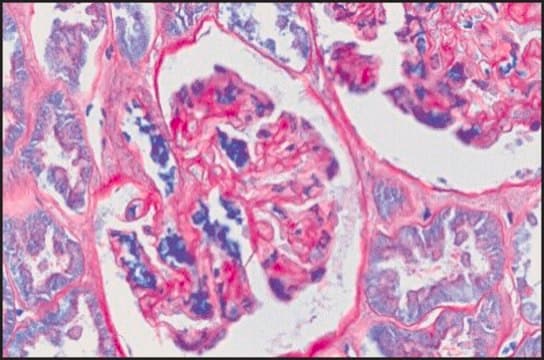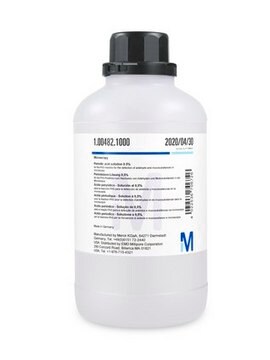1.00524
Periodic acid
for analysis EMSURE®
Synonym(s):
Periodic acid
About This Item
Recommended Products
Quality Level
product line
EMSURE®
assay
≥99.5% (iodometric)
form
solid
impurities
≤0.5% Iodic acid (acidimetric)
ign. residue
≤500 ppm (as sulfates)
pH
1.2 (20 °C, 100 g/L in H2O)
mp
122 °C
solubility
ethanol: soluble at 20 °C
water: soluble at 20 °C
bulk density
1400 kg/m3
anion traces
bromide, bromate, chloride, chlorate (as Cl-): ≤100 ppm
iodide (I-): ≤10 ppm
nitrate (NO3-): ≤10 ppm
sulfate (SO42-): ≤100 ppm
cation traces
Fe: ≤5 ppm
application(s)
histology
storage temp.
15-25°C
InChI
1S/H5IO6/c2-1(3,4,5,6)7/h(H5,2,3,4,5,6,7)
InChI key
TWLXDPFBEPBAQB-UHFFFAOYSA-N
Looking for similar products? Visit Product Comparison Guide
Application
- Histological and Chemical Analysis of Heavy Metals in Kidney and Gills of Boops boops: Melanomacrophages Centers and Rodlet Cells as Environmental Biomarkers.: This study utilized periodic acid in the analytical characterization of heavy metals in marine organisms, providing insights into environmental biomarkers relevant for chemical analysis in aquatic settings (Lauriano ER et al., 2022).
- Histochemical study of the effects on abomasal mucins of Haemonchus contortus or Teladorsagia circumcincta infection in lambs.: Investigates the interaction between parasitic infections and mucosal surfaces, where periodic acid staining could be applied to analyze mucin carbohydrates (Savoian MS et al., 2016).
Analysis Note
Iodic acid (acidimetric): ≤ 0.5 %
Chloride, Chlorate, Bromide, Bromate (as Cl): ≤ 100 ppm
Iodide (I): ≤ 10 ppm
Nitrate (NO₃): ≤ 10 ppm
Sulfate (SO₄): ≤ 100 ppm
Fe (Iron): ≤ 5 ppm
Residue on ignition (as sulfates): ≤ 500 ppm
Legal Information
signalword
Danger
Hazard Classifications
Aquatic Acute 1 - Aquatic Chronic 1 - Eye Dam. 1 - Ox. Sol. 1 - Skin Corr. 1B - STOT RE 1 Oral
target_organs
Thyroid
Storage Class
5.1A - Strongly oxidizing hazardous materials
wgk_germany
WGK 3
flash_point_f
Not applicable
flash_point_c
Not applicable
Certificates of Analysis (COA)
Search for Certificates of Analysis (COA) by entering the products Lot/Batch Number. Lot and Batch Numbers can be found on a product’s label following the words ‘Lot’ or ‘Batch’.
Already Own This Product?
Find documentation for the products that you have recently purchased in the Document Library.
Customers Also Viewed
Our team of scientists has experience in all areas of research including Life Science, Material Science, Chemical Synthesis, Chromatography, Analytical and many others.
Contact Technical Service













